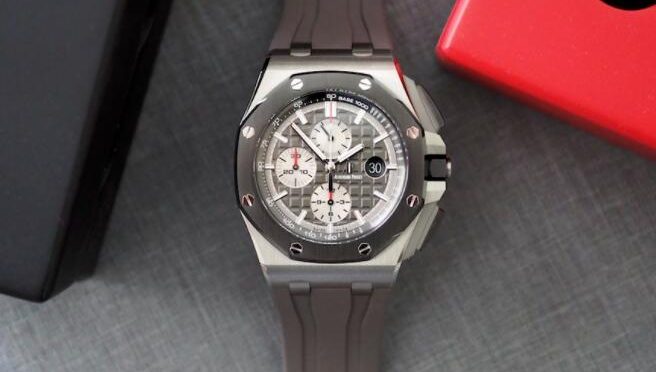
 rubber detailing.
rubber detailing.In part we believe the Offshore wrote the blueprint for large case sizes which ravaged the industry for the next decades. And through the years, the case has somewhat grown even larger in proportions, though it kept mainly circa 44mm. But with special editions exceeding what mere mortals can wear comfortably, topping off with the T3 at 48mm. But through it all, AP always retained a 42mm version of the chronograph which was re-introduced in 2014. This new launch, to be available from September 2021, is now in a new case size of 43mm. And with it, the manufacture’s latest integrated flyback chronograph – the Caliber 4401.
The case remains the same basic shape as the Audemars Piguet Royal Oak Offshore 44mm of old. Even when compared to the original Gueit design, the resemblance is strong. The major changes are that this new case has larger polished chamfers in the edges, and the screw-down crown and chronograph pushers have a slight curvature. The original design had round pushers, but these were replaced with oblong shaped ones in later iterations.
The glareproofed sapphire crystal curved from 6 to 12 o’clock to seamlessly fit the curvature of the bezel and completes the overall design. Alternate surfaces of hand-polished chamfers and satin-brushed finishing adorn the case and bezel furthers the watch’s new aesthetics. With the exception of the all-titanium version, the other four timepieces in the collection feature a ceramic bezel for a two-tone contrast.
The now familiar “Méga Tapisserie” pattern adorns the dial, and is available in black, grey, taupe and blue hues, is newly designed, according to AP to offer enhanced contrast and high-end finishing. The pyramids composing the Tapisserie have been sharpened and connected to one another with a raised cross pattern that adds depth to the dial. The squares topping off the pyramids have been finished with satin-brushing to match with the case’s bold yet refined aesthetics. The pattern is stamped on dial, as is usual for the “Méga Tapisserie”. In contrast the “Petit Tapisserie” used in the Royal Oak is done by a computer controlled guilloché machine.
On the dial, the most significant change noticeable is that the chronograph counters are rearranged, and the minute counter is now at 9 o’clock while the hour counter is at 3 o’clock. The date window is moved to the inner bezel between 4 and 5 o’clock. This redesigned layout is possible due to the new chronograph movement, while the earliest models used a Frédéric Piguet caliber 1185 base module, which had the classical 12/9/6 sub-dial layout.
AP has also abandoned the two line “AP” “Audemars Piguet”logo, in favour of a simpler single line “AP” in applied gold. The hands also appear to be a bolder design, in what AP calls a assertive and powerful stance. The supplied rubber strap is pliable, and feels very comfortable on the wrist, especially with the 43mm “appropriately sized” case. The strap features a quick release and attach mechanism which works well.
Perhaps the most noteworthy of this new ROO 43 is AP’s integerated in-house caliber 4401, which first appeared in the brand’s Code 11.59 Chronograph.
This is an integrated column wheel chronograph with flyback. The 4401 features a vertical clutch mechanism which should reduce the chronograph hands from jumping on activation of the start, stop, reset or flyback functions. We are happy to report that in the short test we conducted with all 5 sample watches, this was indeed the case..
The Audemars Piguet Royal Oak Offshore 44mm competes in a rather strong marketplace. The sports chronograph landscape is perhaps too overpopulated, and to narrow it to include those with a luxury intent from strong manufacture a with in-house chronograph providence. The broader landscape would include the various Sinn chronographs like the Sinn 206 ARKTIS II which are perhaps more workhorses rather than luxury sports chronographs.